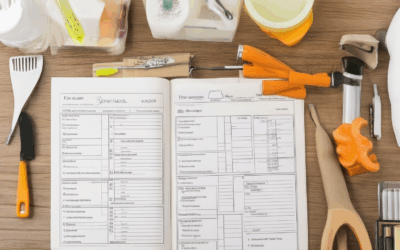Keeping up with home maintenance can feel overwhelming, especially when you’re juggling a busy schedule and a household to manage. But imagine if there was a simple rule that could make it all easier—something that ensures your home stays in top shape without constant stress or expense. Whether you’re a seasoned homeowner or new to the game, discovering the 1 rule every homeowner should know can transform your approach to home upkeep. From preventing minor issues from becoming major headaches to saving time and money in the long run, mastering the basics of home maintenance is key to preserving your investment. In this guide, we’ll explore what that essential rule is, how to implement it, and why it matters for keeping your living space in peak condition. Let’s dive in and uncover the secrets to hassle-free home upkeep!
Key Takeaways
- Schedule regular home inspections to catch potential issues early and maintain your property’s value.
- Prioritize early detection of leaks, pests, and other home maintenance concerns to avoid costly repairs.
- Combine DIY home upkeep with professional services to ensure thorough and reliable maintenance.
- Establish a comprehensive maintenance routine to keep your home in top shape year-round.

The 1 Rule for Home Maintenance
When it comes to home maintenance, one essential rule to follow is the 1% rule . This rule helps you estimate how much money you should set aside annually for home maintenance. Here’s how it works:
- Assess the current value of your home.
- Calculate 1% of that value. For example, if your home is valued at $250,000, 1% amounts to $2,500 per year.
- Set aside this amount specifically for home maintenance expenses.
This rule is particularly useful because homes require ongoing care, and having a dedicated fund helps cover unexpected repairs and replacements without dipping into other budget categories. However, it’s important to also:
- Inspect regularly : Check for signs of wear, leaks, or pests at least twice a year to catch issues early.
- Plan for replacements : Replace major systems like roofing, HVAC, and plumbing when needed, even if they’re still functioning well, to prevent sudden breakdowns.
- Keep an emergency fund : In addition to your 1% rule, save some money for unexpected emergencies like appliance failures or natural disasters.
- Tackle projects promptly : Address maintenance tasks as they arise to avoid minor issues escalating into major problems.
- Consult professionals : For complex tasks, hire qualified contractors to ensure everything is done safely and correctly.
By combining the 1% rule with these supplementary strategies, you’ll be well-prepared to keep your home in great shape for years to come.
How to Properly Maintain Your House
To maintain your house effectively, follow these essential steps:
Exterior Maintenance
- Gutters: Clean and clear gutters regularly to prevent water damage and overflow.
- Trim Trees: Regularly trim trees and bushes to avoid damage to your roof and windows.
- Roof Inspection: Check for missing or damaged shingles and repair as needed.
- Siding: Pressure wash your siding to remove dirt and prevent mold growth.
Indoor Systems
- HVAC System: Change air filters every 3 months and inspect vents for blockages.
- Thermostat: Program your thermostat to save energy and reduce costs.
- Ductwork: Clean ducts annually to improve air quality and energy efficiency.
Electrical Safety
- Outlets and Switches: Check for tripped circuits and ensure all outlets work properly.
- Circuit Breakers: Test and reset as needed, following manufacturer guidelines.
- Outdoor Outlets: Test before use, especially after severe weather.
- GFCI Outlets: Install and maintain for added safety.
Plumbing
- Leaky Pipes: Check under sinks for leaks and fix them promptly.
- Faucets: Repair drips and replace worn-out fixtures.
- Water Heater: Flush annually to remove sediment and extend lifespan.
Appliance Care
- Refrigerator: Clean coils and inspect hoses for kinks or leaks.
- Dishwasher: Keep hoses free from kinks and replace when necessary.
- Appliance Hoses: Inspect and protect from freezing temperatures.
Fire Safety
- Smoke Detectors: Test monthly and replace batteries as needed.
- Carbon Monoxide Detectors: Check functionality and replace detectors every 10 years.
- Fire Extinguishers: Check expiration dates and ensure they’re accessible.
- Emergency Plan: Practice escape routes with your family regularly.
Landscaping
- Lawn Care: Mow regularly, dethatch, and apply fertilizer at the right times.
- Pruning: Trim trees and shrubs to encourage healthy growth.
- Pest Control: Monitor for pests and treat as needed.
Water Features
- Pool/Spa: Skim debris weekly and check for leaks.
- Chlorination: Maintain proper levels to keep water safe and clear.
Windows and Doors
- Check for Damage: Look for cracks and leaks around windows and doors.
- Weatherstripping: Replace old strips to improve energy efficiency.
- Window Cleaning: Clean regularly to prevent dirt buildup.
Foundation and Structural Integrity
- Inspect Foundation: Look for cracks or movement that could indicate structural issues.
- Crack Repairs: Address cracks promptly to prevent further damage.
Chimney and Flue
- Inspect Chimney: Check for damage and obstructions, and clean creosote buildup as needed.
Security Systems
- Test Alarms: Ensure your security system functions properly and is armed when needed.
- Locks and Keys: Maintain and replace locks as necessary for optimal security.
- Monitoring: Regularly check and update your monitoring system.
Budgeting and Organization
- Maintenance Schedule: Create a calendar to track tasks and costs.
- Professional Help: Know when to hire contractors for specialized tasks.
- Tool Storage: Keep tools organized and easily accessible for maintenance tasks.
By following these guidelines, you can ensure your house remains in great shape, reducing the need for costly repairs and extending its lifespan.

What Routine Maintenance Is Required for a House?
Keeping your house in great shape requires regular maintenance to prevent issues before they arise. Here’s a comprehensive guide to the essential tasks:
- Check for Leaks
- Inspect pipes under sinks, bathtubs, and toilets for visible leaks.
- Look for water damage around fixtures or flooring.
- Test exposed pipes for rust or corrosion.
- Clean Gutters and Downspouts
- Remove debris like leaves, branches, and dirt from gutters and downspouts.
- Ensure water flows freely to prevent water buildup and foundation issues.
- Examine Windows and Doors
- Check for cracks, gaps, or peeling paint in window frames and doors.
- Insulate windows to improve energy efficiency.
- Lubricate door hinges and ensure screens are intact.
- Service HVAC Systems
- Schedule a professional inspection of your furnace, air conditioning, and ductwork.
- Replace or clean air filters monthly to maintain airflow and efficiency.
- Check for signs of wear or damage in vents and ducts.
- Inspect the Roof
- Look for missing shingles, curling edges, or damage from weather.
- Clear debris like leaves and branches from roof surfaces.
- Check for sagging or uneven areas that may indicate structural issues.
- Test Smoke Detectors and Carbon Monoxide Sensors
- Ensure smoke detectors and CO sensors are functioning properly.
- Replace batteries as needed, typically twice a year.
- Clean and Service Appliances
- Daily cleaning of major appliances like refrigerators, stoves, and dishwashers.
- Monthly servicing of washing machines, dryers, and garbage disposals.
- Check for worn-out parts or necessary repairs.
- Check Foundation for Cracks or Damage
- Inspect the perimeter of your house for cracks or shifting.
- Look for signs of moisture or rot around the foundation.
- Contact a professional if you notice significant issues.
- Service Landscaping
- Trim trees and bushes to prevent overgrowth.
- Mow and edge lawn areas regularly.
- Inspect for pests or weeds that may harm your property.
- Review Insurance Policies
- Verify that your home insurance covers risks like fire, storm damage, and theft.
- Update policies as needed to reflect changes in your home or circumstances.
- Check for Pest Infestations
- Inspect for ants, spiders, rodents, or other pests.
- Seal entry points to prevent future infestations.
- Contact a professional exterminator if needed.
- Test Water Pressure and Pipes
- Check water pressure to ensure it meets local standards.
- Listen for unusual noises that may indicate pipe issues.
- Address low water pressure or discolored water promptly.
- Inspect Driveways and Walkways
- Look for cracks, potholes, or uneven surfaces.
- Fix or repair areas that are unsafe or aesthetically pleasing.
- Service Garage and Storage Areas
- Organize and clean storage spaces to prevent clutter.
- Inspect the garage door for proper function and safety.
- Check for pests or rodent activity in storage areas.
- Review Energy Efficiency
- Check for energy-efficient improvements like insulation or window upgrades.
- Consider upgrading to more efficient appliances.
- Lower energy bills through regular maintenance and updates.
- Inspect Fire Safety Equipment
- Ensure smoke detectors and fire extinguishers are functional.
- Replace old or expired equipment as needed.
- Plan for Seasonal Upkeep
- Create a calendar for tasks like gutter cleaning, HVAC service, and landscaping.
- Adjust routines based on seasonal changes to maintain peak performance.

Who is Kyshawn’s weekly home check?
Kyshawn Lane is the individual behind the weekly home check. As a passionate content creator and homeowner, Kyshawn specializes in home maintenance, DIY projects, and product recommendations. His expertise helps homeowners improve their living spaces through engaging videos and practical advice.
Kyshawn’s weekly home check involves a thorough inspection of various aspects of a property, including checking for potential issues like leaks, pests, or maintenance needs. This routine allows him to provide valuable insights and recommendations to help homeowners maintain their properties effectively.
His approach to home maintenance is rooted in providing accessible and actionable information, making it easier for individuals to tackle DIY projects and routine upkeep. By sharing detailed tips and guides, Kyshawn empowers his audience to manage their homes with confidence.
For more information about Kyshawn Lane and his work, you can visit his LinkedIn profile:
LinkedIn Profile
What is the Upkeep of a House?
The upkeep of a house refers to the routine maintenance tasks necessary to ensure the property remains in good condition. Proper upkeep helps prevent costly repairs and extends the lifespan of your home. Here’s a breakdown of essential tasks:
Exterior Maintenance
- Painting:** Regularly repaint exterior surfaces to protect against weather damage and maintain curb appeal.
- Deck and Fence Maintenance:** Check for wear and tear, repair or replace boards, and apply sealants or stains as needed.
- Gutter Cleaning:** Remove debris and ensure gutters are functioning properly to direct water away from the foundation.
- Roof Inspection:** Look for missing shingles, leaks, or damage, and address issues promptly.
- Driveway and Walkway Maintenance:** Clean and inspect for cracks or uneven surfaces, and consider sealing if necessary.
Interior Maintenance
- Deep Cleaning:** Regularly clean floors, walls, and surfaces to maintain hygiene and prevent dust buildup.
- Appliance Care:** Clean and maintain appliances like refrigerators, stoves, and HVAC systems for optimal performance.
- Bathroom and Kitchen Maintenance:** Clean tiles, grout, and fixtures, and check for leaks or water damage.
- Attic and Basement Inspections:** Ensure storage areas are organized and free of moisture or pests.
HVAC and Plumbing Systems
- Heating and Cooling Systems:** Schedule regular tune-ups to ensure efficient operation and prevent breakdowns.
- Plumbing Checks:** Inspect pipes for leaks, clogs, or damage, and address issues promptly to prevent water damage.
- Water Heater Maintenance:** Flush tanks and check for corrosion or sediment buildup to extend appliance life.
Electrical System
- Outlet and Switch Inspections:** Regularly check for tripped circuits or flickering lights, and address any issues immediately.
- Ground Fault Circuit Interrupter (GFCI) Testing:** Ensure GFCIs function properly to protect against electrical hazards.
- Lighting Updates:** Replace outdated or inefficient bulbs with energy-efficient options to reduce utility costs.
Landscape and Outdoor Features
- Lawn Care:** Mow, edge, and fertilize grass to maintain a healthy lawn and prevent weeds.
- Garden Maintenance:** Prune plants, remove dead leaves, and ensure proper watering to keep green spaces thriving.
- Patio and Pool Area Checks:** Clean and inspect surfaces for cracks or damage, and perform necessary repairs.
Safety Checks
- Fire Safety:** Test smoke detectors and ensure fire extinguishers are functional and accessible.
- Carbon Monoxide Detector Testing:** Ensure detectors are working properly to safeguard your family.
- Lock and Door Security:** Regularly check locks and ensure doors are secure to prevent unauthorized entry.
By staying proactive with these maintenance tasks, you can preserve your home’s value and ensure a safe, comfortable living environment. For more detailed guides and professional advice, visit Sams Maintenance .

What Are Some Easy Home Upkeep Tips?
We understand the importance of maintaining a comfortable and safe living environment. At Sams Maintenance, we offer practical advice and resources to help you keep your home in top shape. Here are some simple yet effective home upkeep tips:
1. Schedule Regular Cleaning
Regular cleaning is essential for maintaining hygiene and preventing dirt buildup. Create a weekly cleaning schedule to tackle different areas of your home, such as bathrooms, kitchens, and living rooms. This routine will save you time and ensure your space stays fresh.
2. Check for Leaks Early
Water leaks can cause significant damage if left untreated. Inspect pipes, faucets, and fixtures regularly. Fix minor issues before they escalate into major problems. We recommend using our water leak detection guide for more details.
3. Maintain Air Filters
Clean or replace air filters monthly to ensure your HVAC system runs efficiently. Dirty filters can lead to poor indoor air quality and higher energy bills. Our air filter cleaning tips provide step-by-step instructions for maintaining your filters.
4. Test Smoke Detectors Monthly
Fire safety is crucial. Monthly test your smoke detectors to ensure they’re functioning properly. Replace batteries as needed, and consider upgrading to newer models with advanced features. Learn more about fire prevention tips in our fire safety guide .
5. Trim Trees and Shrubs
Overgrown trees and shrubs can cause damage to your home or block walkways. Regularly trim them to maintain your property’s appearance and prevent potential hazards. Use our landscape maintenance guide for professional advice.
6. Inspect Gutter Systems
Gutters play a vital role in protecting your home from water damage. Clean them twice a year and check for cracks or blockages. Our gutter repair guide helps you address issues before they become costly problems.
7. Schedule Professional Services
While some home upkeep tasks are DIY-friendly, others may require professional expertise. Schedule regular inspections for tasks like HVAC servicing, plumbing, and roof maintenance. Trust our professional upkeep services to ensure everything runs smoothly.
8. Organize Storage Areas
Keep your home clutter-free by organizing storage spaces. Use bins, shelves, and labels to make it easier to find items quickly. This will also reduce the risk of accidents and make cleaning more efficient. Explore our storage organization tips for more ideas.
9. Monitor Energy Usage
High energy bills can strain your budget. Track your energy consumption and identify areas for improvement. Adjust your thermostat, seal windows, and upgrade to more efficient appliances. Discover ways to lower your energy costs in our energy saving tips article.
10. Plan for Seasonal Upkeep
Seasonal changes affect your home’s maintenance needs. Prepare for tasks like gutter cleaning in fall and lawn care in spring. Use our seasonal maintenance guide to stay ahead of the curve.
In addition to these tips, remember to inspect your home regularly for signs of wear and tear. Address issues promptly to prevent minor problems from becoming major ones. Keeping your home well-maintained not only enhances your living experience but also increases its longevity and value.
For more detailed guidance and exclusive resources, visit Sams Maintenance . We provide comprehensive tools and expert advice to help you maintain your home effectively.




0 Comments